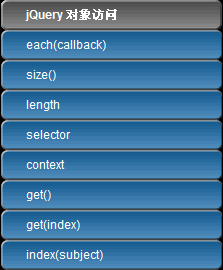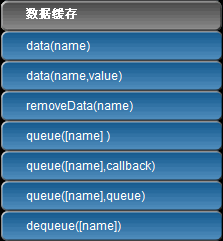前言
上篇主要介绍JQuery的核心函数的原理机制,这篇将开始介绍jQuery对象访问和数据缓存原理,主要内容包括:


分析
一、jQuery对象访问
1. 【each(callback)】
例子:
| HTML代码 | jQuery代码 | 运行结果 |
| <img/><img/> | $("img").each(function(i){ |
[ <img src="test0.jpg" />, <img src="test1.jpg" /> ] |
| <img/><img/> | $("img").each(function(){ |
切换样式example |
现在来看each方法的具体实现如下:
each: function ( callback, args ) {
return jQuery.each( this , callback, args );
}
}
可以看到它返回的是全局的each方法,并且将自身jQuery对象做为参数给它,全局的each方法的具体实现如下:
each: function ( object, callback, args ) {
var name, i = 0 , length = object.length; // 当object为jQuery对象时,length非空
if ( args ) {
if ( length === undefined ) {
for ( name in object )
if ( callback.apply( object[ name ], args ) === false )
break ;
} else
for ( ; i < length; )
if ( callback.apply( object[ i ++ ], args ) === false )
break ;
// 以下是客户端程序进行调用
} else {
if ( length === undefined ) {
for ( name in object )
if ( callback.call( object[ name ], name, object[ name ] ) === false )
break ;
} else
for ( var value = object[ 0 ];
i < length && callback.call( value, i, value ) !== false ; value = object[ ++ i] ){}
}
return object;
}
现在我们关注下 for ( var value = object[0]; i < length && callback.call( value, i, value ) !== false; value = object[++i] ){} 这句代码;
其中object[0]取得jQuery对象中的第一个DOM元素,通过for循环,得到遍历整个jQuery对象中对应的每个DOM元素,通过callback.call( value,i,value); 将callback的this对象指向value对象,并且传递两个参数,i表示索引值,value表示DOM元素;其中callback是类似于 function(index, elem) { ... } 的方法。所以就得到 $("...").each(function(index, elem){ ... });
2. 【size()】和【length】
这两个都是得到jQuery 对象中元素的个数,具体实现如下:
return this .length;
}
3. 【selector】和【context】
selector返回传给jQuery()的原始选择器。
context返回传给jQuery()的原始的DOM节点内容,即jQuery()的第二个参数。如果没有指定,那么context指向当前的文档(document)。
这两个属性在上一篇文章也有提及,请参考jQuery.API源码深入剖析以及应用实现(2) - 对象访问和数据缓存 ,这里不再敖述。
4. 【get()】和【get(index)】
get()取得所有匹配的 DOM 元素集合。
get(index)取得其中一个匹配的DOM元素,index表示取得第几个匹配的元素。
$(this).get(0)与$(this)[0]等价。
现在看下get方法的具体实现如下:
return num === undefined ?
// 当num为undefined时,返回所有匹配的DOM元素集合
jQuery.makeArray( this ) :
// 当num不为undefined时,返回第num+1个匹配的DOM元素
this [ num ];
}
当不包含num时,调用jQuery.makeArray方法,具体实现如下:
var ret = [];
if ( array != null ){
var i = array.length;
// The window, strings (and functions) also have 'length'
if ( i == null || typeof array === " string " || jQuery.isFunction(array) || array.setInterval )
ret[ 0 ] = array;
else
while ( i )
ret[ -- i] = array[i];
}
return ret;
}
可以看出这里的array为jQuery对象,因此执行 while( i ) ret[--i] = array[i]; , 返回的是以array所有匹配的DOM元素所组成的数组。这和前面的定义相一致。
当包含num时,直接返回 this[ num ],所以这样验证了 $(this).get(0)与$(this)[0]等价 的说明。
5. 【index(subject)】
搜索与参数表示的对象匹配的元素,并返回相应元素的索引值。
例子
| HTML代码 | jQuery代码 |
| <div id="foobar"><div></div><div id="foo"></div></div> | $("div").index($('#foobar')[0]) // 0 |
现在看下index方法的具体实现如下:
return jQuery.inArray(
// 如果elem为一个jQuery对象,那么得到的是第一个匹配的DOM元素
elem && elem.jquery ? elem[ 0 ] : elem
, this );
}
继续查看jQuery.inArray方法,具体实现如下:
for ( var i = 0 , length = array.length; i < length; i ++ )
// Use === because on IE, window == document
if ( array[ i ] === elem )
return i;
return - 1 ;
}
一目了然,返回elem的索引值。
二、数据缓存
1. 【data(name)】和【data(name,value)】
data(name)返回元素上储存的相应名字的数据,可以用data(name, value)来设定。
data(name,value)在元素上存放数据,同时也返回value。
例子
| HTML代码 | jQuery代码 |
| <div></div> | $("div").data("blah"); // undefined |
| <div></div> | $("div").data("test", { first: 16, last: "pizza!" }); |
现在来看看data方法的具体实现:
data: function ( key, value ){
var parts = key.split( " . " );
parts[ 1 ] = parts[ 1 ] ? " . " + parts[ 1 ] : "" ;
if ( value === undefined ) {
var data = this .triggerHandler( " getData " + parts[ 1 ] + " ! " , [parts[ 0 ]]);
if ( data === undefined && this .length )
data = jQuery.data( this [ 0 ], key );
return data === undefined && parts[ 1 ] ?
this .data( parts[ 0 ] ) :
data;
} else
return this .trigger( " setData " + parts[ 1 ] + " ! " , [parts[ 0 ], value]).each( function (){
jQuery.data( this , key, value );
});
},
removeData: function ( key ){
return this .each( function (){
jQuery.removeData( this , key );
});
}
});
当我们要在元素上存放数据的时候,比如 $("div").data("blah","hello"); 将执行这句代码:
return this.trigger("setData" + parts[1] + "!", [parts[0], value]).each(function(){jQuery.data( this, key, value );});
我们看下jQuery.data(this,key,value);这句代码,继续展开jQuery.data方法的具体实现以及相关其他代码:
return + new Date;
}
var expando = " jQuery " + now(), uuid = 0 , windowData = {};
jQuery.extend({
cache: {},
data: function ( elem, name, data ) {
elem = elem == window ?
windowData :
elem;
var id = elem[ expando ];
// 在元素上产生唯一的ID
if ( ! id )
id = elem[ expando ] = ++ uuid;
// 当我们试着访问一个键是否含有值的时候,如果不存在jQuery.cache[id]值, 初始化jQuery.cache[id]值
if ( name && ! jQuery.cache[ id ] )
jQuery.cache[ id ] = {};
// 防止一个undefined的值覆盖jQuery.cache对象
if ( data !== undefined )
jQuery.cache[ id ][ name ] = data;
return name ?
jQuery.cache[ id ][ name ] :
id;
}
});
其中这句代码
if ( data !== undefined )
jQuery.cache[ id ][ name ] = data;
将data存储在cache对象中。
当我们需要返回元素上储存的相应名字的数据的时候,比如 $("div").data("blah"); 主要将执行这句代码:
data = jQuery.data( this[0], key );
最后将返回一个保存在 jQuery.cache[ id ][ name ] 中的数据。
2. 【removeData(name)】
在元素上移除存放的数据。具体实现如下:
return this .each( function (){
jQuery.removeData( this , key );
});
}
继续展开jQuery.removeData方法的具体实现:
elem = elem == window ?
windowData :
elem;
var id = elem[ expando ];
if ( name ) {
// elem是否存在元素cache
if ( jQuery.cache[ id ] ) {
// 移除一个具有特定键的元素数据
delete jQuery.cache[ id ][ name ];
// 将键值置空,准备移除元素cache
name = "" ;
for ( name in jQuery.cache[ id ] )
break ;
if ( ! name )
jQuery.removeData( elem );
}
} else {
// Clean up the element expando
try {
delete elem[ expando ];
} catch (e){
// IE has trouble directly removing the expando
// but it's ok with using removeAttribute
if ( elem.removeAttribute )
elem.removeAttribute( expando );
}
// 完全移除元素cache
delete jQuery.cache[ id ];
}
}
通过调用 delete jQuery.cache[ id ][ name ]; 和 delete jQuery.cache[ id ];,移除所有该元素上的cache数据;
3. 【queue([name])】,【queue([name],callback)】和【queue([name],queue】
例子
| HTML 代码 | jQuery 代码 |
<style>
div { margin:3px; width:40px; height:40px;
position:absolute; left:0px; top:30px;
background:green; display:none; }
div.newcolor { background:blue; }
span { color:red; }
</style>
<button id="show">Show Length of Queue</button>
<span></span>
<div></div> |
$("#show").click(function () {
var n = $("div").queue("fx");
$("span").text("Queue length is: " + n.length);
});
function runIt() {
$("div").show("slow");
$("div").animate({left:'+=200'},2000);
$("div").slideToggle(1000);
$("div").slideToggle("fast");
$("div").animate({left:'-=200'},1500);
$("div").hide("slow");
$("div").show(1200);
}
runIt(); |
<style>
div { margin:3px; width:40px; height:40px;
position:absolute; left:0px; top:30px;
background:green; display:none; }
div.newcolor { background:blue; }
</style>
Click here...
<div></div> |
$(document.body).click(function () {
$("div").show("slow");
$("div").animate({left:'+=200'},2000);
$("div").queue(function () {
$(this).addClass("newcolor");
$(this).dequeue();
});
$("div").animate({left:'-=200'},500);
$("div").queue(function () {
$(this).removeClass("newcolor");
$(this).dequeue();
});
$("div").slideUp();
}); |
<style>
div { margin:3px; width:40px; height:40px;
position:absolute; left:0px; top:30px;
background:green; display:none; }
div.newcolor { background:blue; }
</style>
<button id="start">Start</button>
<button id="stop">Stop</button>
<div></div> |
$("#start").click(function () {
$("div").show("slow");
$("div").animate({left:'+=200'},5000);
$("div").queue(function () {
$(this).addClass("newcolor");
$(this).dequeue();
});
$("div").animate({left:'-=200'},1500);
$("div").queue(function () {
$(this).removeClass("newcolor");
$(this).dequeue();
});
$("div").slideUp();
});
$("#stop").click(function () {
$("div").queue("fx", []);
$("div").stop();
}); |
由于div节点产生动画效果,每条动画就调用一个jQuery.data方法,将每条动作保存在jQuery.cache中,就形成了缓存队列。至于div节点产生动画效果如何调用jQuery.data方法会在以后的章节中介绍。
请看第一行的例子,可以看到这里包含7条动作效果,也就是在还没有执行它们以前,如果调用 var n = $("div").queue("fx"); 返回一个队列对象n,查看该对象的长度,发现队列长度为7,而每执行完一条动作,队列长度就会减1。
再看第二行的例子,queue的第一个参数为一个函数,当执行完这个自定义函数后,要继续执行队列,这要调用dequeue方法。
再看第三行的例子,queue的第二个参数为一个数组,实际上它可以是一个新队列或者现有队列去替代当前队列,其中新队列或者现有队列的值和queue(callback)相同。
现在看看queue的具体实现:
if ( typeof type !== " string " ) {
data = type;
type = " fx " ;
}
if ( data === undefined )
{
return jQuery.queue( this [ 0 ], type );}
return this .each( function (){
var queue = jQuery.queue( this , type, data );
if ( type == " fx " && queue.length == 1 )
queue[ 0 ].call( this );
});
}
其中 if(typeof type !== "string") { data = type; type = "fx"; } 可以得出fx为默认的队列名称。继续查看jQuery.queue方法:
if ( elem ){
type = (type || " fx " ) + " queue " ;
var q = jQuery.data( elem, type );
if ( ! q || jQuery.isArray(data) )
q = jQuery.data( elem, type, jQuery.makeArray(data) );
else if ( data )
q.push( data );
}
return q;
}
归根结底最后通过jQuery.data从jQuery.cache对象获得数据。jQuery.isArray(data) 判断是否是新队列或者现有队列数组。
4. 【dequeue([name])】
从队列最前端移除一个队列函数,并执行它。
dequeue的具体实现为:
return this .each( function (){
jQuery.dequeue( this , type );
});
}
然后查看jQuery.dequeue方法的具体实现如下:
var queue = jQuery.queue( elem, type ),
fn = queue.shift();
if ( ! type || type === " fx " )
fn = queue[ 0 ];
if ( fn !== undefined )
fn.call(elem);
}
可以发现最后通过 fn=queue.shift();或者fn=queue[0]得到队列的第一个元素,然后fn.call(elem);去执行它。
好了,jQuery对象访问和数据缓存的原理机制就是这样的。